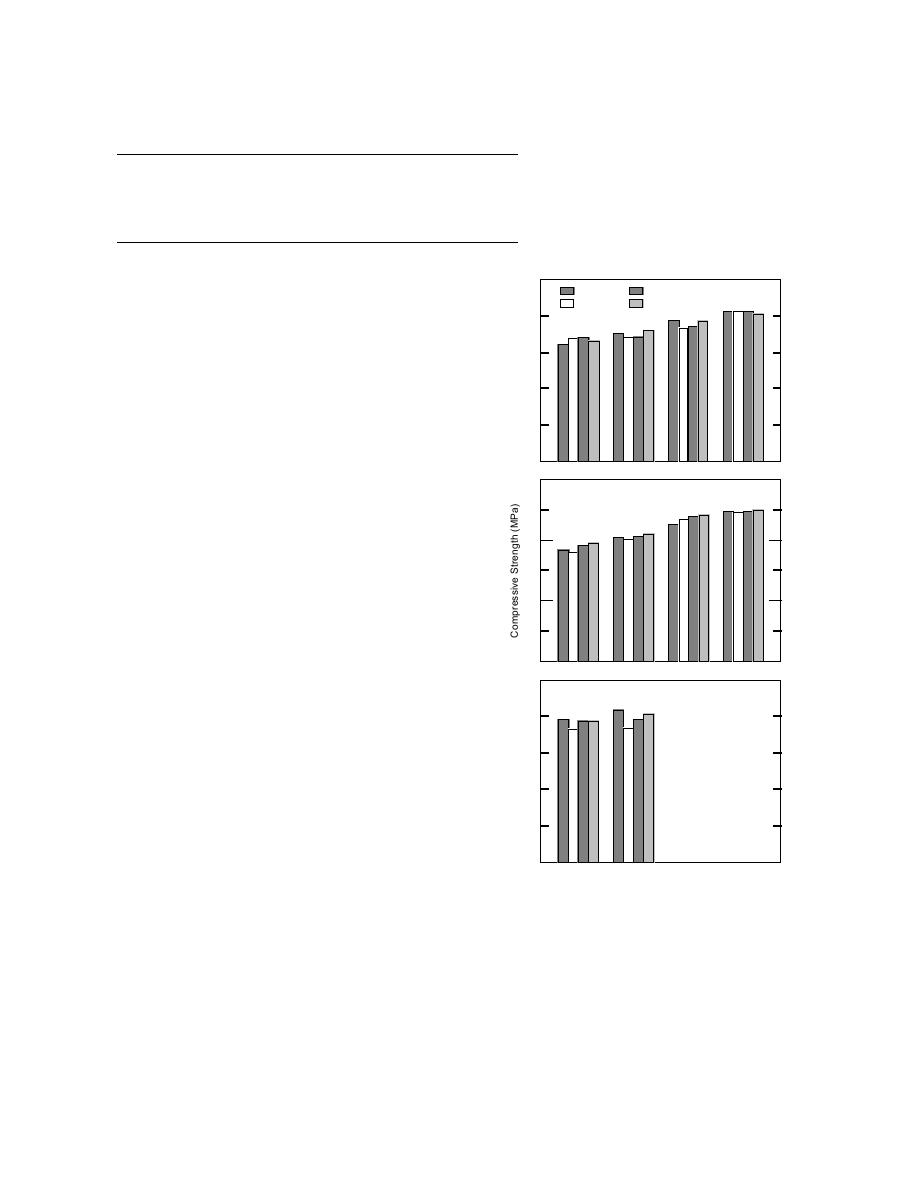
had a positive effect on when concrete
Table 9. Equivalent insulation values for 5.4-cm- (6 in.) thick
wall maintained at 10C (50F) for seven days.
can first be frozen. For both of the Type
I cement mixtures (Fig. 5a and b),
Air temperature
Required thermal resistance Equivalent fibrous
Pozzutec 20 produced a 28-day strength
C (F)
m2 K/W (hr ft2 F/Btu)
Mixture
glass--mm (in.)
that exceeded that of the admixture-
free control, regardless of the strength
2,1
2 (37)
1.0 (5.7)
47 (1.8)
2,2
1 (34)
1.1 (6.3)
52 (2.0)
at which the concrete was frozen. The
2,3
0 (32)
1.2 (6.9)
56 (2.2)
exception to this was for the Type III
*2,0
2 (28)
1.4 (8.1)
66 (2.6)
cement mixture (Fig. 5c), where Pozzu-
*2,2
4 (25)
1.6 (9.2)
75 (3.0)
tec 20 caused a 5% decrease in the 28-
* Denotes Type III cement.
50
Room
3.4 MPa
a.
1.7 MPa
5.2 MPa
Table 9 shows the amount of insulation that
40
the various mixtures tested can replace. The table
is based on ACI requirements to maintain a 150-
30
mm- (6 in.) thick wall of concrete made with Type
I cement at a cement factor of 365 kg/m3 (611 lb/
20
yd3) at 10C (50F) for seven days. For instance,
according to ACI, an ambient air temperature of
10
0C (32F) requires insulation to have a thermal
0
2, 0
2, 1
2, 2
2, 3
which is equivalent to 56 mm (2.2 in.) of fibrous
60
b.
glass insulation. Pozzutec 20 dosed at 100 mL/kg
(150 fl oz/cwt) is equivalent to that amount of
insulation (Table 9).
40
Task 5: Critical strength
The objective of this task was to determine if
20
Pozzutec 20 affected the minimum strength at
which concrete can be frozen without being frost-
damaged. The critical freezing strength of normal
air-entrained concrete, according to ACI 1988, is
0
3, 0
3, 1
3, 2
3, 3
3.5 MPa (500 psi). A complete list of strength
50
results at all test ages is provided in Appendix B.
c.
Figure 5 highlights this data by showing the 28-
40
day strengths for the 365-kg/m3 (611 lb/yd3) ce-
ment factor of Type I and III cement. These data
30
provide evidence of the effect of Pozzutec 20 on
the critical freezing strength of concrete.
20
Before discussing the effects of Pozzutec 20, it
is worth noting in Figure 5 that the three admix-
10
ture-free concretes, i.e., (2,0), (3,0), and (*2,0), were
unaffected by one cycle of freezing and thawing
0
*2, 0
*2, 2
once they had attained a compressive strength of
3.4 MPa (500 psi). The freezing actually produced
Figure 5. Effect of early age freezing on con-
a slightly stronger concrete for the Type I cement
crete strength. The concretes were placed in a
20C (4F) room for 24 hours after they
and showed no ill effect for the Type III cement. It
is interesting to note that the 3.5 MPa (500 psi)
attained a specified compressive strength. They
critical strength value is for air-entrained con-
were then removed from the cold room and
crete. The concretes in this study were non-air-
cured at room temperature. This graph com-
entrained. Thus, the real critical strength is prob-
pares the 28-day strength of control concrete
ably less than that given by ACI.
that was never frozen to those of the concretes
The addition of Pozzutec 20 to the concrete
that were frozen once.
10



 Previous Page
Previous Page
